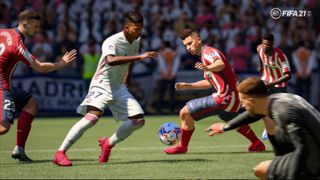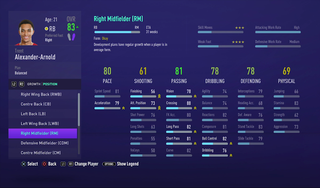
Generally speaking, I think FIFA gets a bad rap.
Yes, it’s rage-inducing. Yes, it’s the same every year. Yes, it could be construed as a gambling platform for teens. But it’s also still the best football simulator money can buy (sorry, PES). For that reason, it remains the go-to game for millions of soccer fans around the world, including the pros.
That being said, FIFA 21’s career mode still sucks. It’s really not good, especially after EA claimed that the management mode was getting a major overhaul before the game's release. Hell, it even warranted a dedicated trailer for the first time in forever, so I was frustrated to discover that career mode is still the same old dialogue-clicking, training-skipping simulator as previous entries in the series.
- PS5 vs Xbox Series X: which console is right for you?
- Best PS5 games: don't miss these top titles
- Best Xbox Series X games: jump into these great games
But hey, I just said FIFA is the same game every year, so what did I expect.
Pre-season promises

On paper, FIFA 21’s “manage every moment” ambitions for career mode sound great. On the back of Football Manager’s increased popularity in recent years, a FIFA game offering more immersive managerial involvement could only prove a welcome direction for the franchise, especially considering the historically gameplay-focused nature of the series.
But what EA meant to say when it was throwing around lines like “new depth in matches, transfers and training” was that it had actually just made existing game mechanics more tedious under the guise of deepening the experience for the player.
The main "changes" (let’s go with EA’s phrasing here) come in the form of an interactive match sim, more detailed player development, active training and scheduling, new transfer options and enhanced opposition A.I.
Get daily insight, inspiration and deals in your inbox
Get the hottest deals available in your inbox plus news, reviews, opinion, analysis and more from the TechRadar team.
Let’s start gently. The first in the list, in fairness, is a welcome addition, allowing you to jump in-and-out of simulated matches on the fly if your team isn’t quite delivering the tiki-taka style football you hoped for. The new player development features, too, are also genuinely fresh, giving you the option to train players in different positions should you wish to turn Wan-Bissaka from a defensive right back into a marauding winger (good luck with that, by the way).
Training day

"Seriously, there are just too many menus and submenus to warrant the arduous journey you'll need to embark on to find out exactly how to put this player in that position or have your team play in a certain way."
Ultimately, though, you'll end up being dissuaded from seeing what novel features like this have to offer because of the awful user interface in FIFA 21's career mode. Seriously, there are just too many menus and submenus to warrant the arduous journey you'll need to embark on to find out exactly how to put this player in that position or have your team play in a certain way.
This tedium is made even more apparent by the new active training and scheduling feature. In theory, these tools should empower you to flex your footballing philosophy by deciding which days in the calendar are used for training, resting and recovery. But in reality, this is easily the worst thing about career mode. You now have to monitor match sharpness alongside player morale and fitness, finding the right balance between honing your plans on the training pitch and awarding your team adequate rest to prepare for the next game.
It all sounds very Pep Guardiola, but it’s actually just super annoying. Between each game, you’ll have to decide which training sessions to simulate, skip or play out yourself (Godspeed to those that do), and you end up spending far more time sifting through the training schedule than you do performing the managerial tasks that are actually fun – like scouting players, brokering transfers and tweaking formations.
Kudos to EA for at least beefing up the training options, but if players were after a career mode that focused so much on the backroom, off-the-pitch elements of management, they’d just play Football Manager. And even with these new options, you’re still by-and-large unable to craft your own style of football – at least any sort of identity beyond those afforded by your choice of formation.
All this means that FIFA 21's career mode lacks the tactical micromanagement that the Football Manager series excels at, and instead aims for some sort of middle ground between game and clipboard that just makes you wish it had stuck to its sim-to-next-match roots.
Against the run of play

Yes, FIFA 21's career mode is different to FIFA 20, but only in that it gives the player more of the same – more training, more scheduling, more replying to emails. What I – and, I suspect, most players – want to see is not the augmentation of existing systems, but entirely new ones.
FIFA’s bottom line has always been about offering players the opportunity to experience the thrill of football from their sofas. The appeal of career mode, in particular, lies in the opportunity to build and play with an unrealistically-good team of Galacticos, the romantic pursuit of bringing a Championship team to the height of the Premier League or the journey of watching promising youngsters grow into megastars. It’s about progression, not maintenance. We need to be able to upgrade stadiums, purchase sponsorships and create new kits, not trudge through seasons where we spend half the time simulating training sessions.
Ironically, the career modes of old encouraged the idea of progression more than FIFA 21. Stadium and income growth used to be a feature of previous entries, simpler times when you could hop from game to game with ease and crack out ten genuinely-enjoyable games in an evening playthrough. Nowadays, though, your eyes have turned square by the time you finish pre-season because you’ve clicked through so many menus and tiles it physically hurts to simulate Tuesday night shooting practice.
Caught napping

Career mode symbolizes EA’s laziness the most, too. The same backgrounds as last year are used for press conferences and transfer negotiations, as well as the same (downright lifeless) dialogue options. Quite laughably, even some of the supposedly ‘new’ mechanics are actually just re-added features that were previously canned by the developer. The addition of a shiny new loan-to-buy option when signing players in the latest game, for example, isn’t new at all, but a contract element that was removed after FIFA 15. Did EA think we wouldn’t notice?
Ultimate Team will always prevail as EA’s most prized asset, that much is clear enough – and there’s nothing wrong with that. FUT is a cash cow like nothing else in the gaming industry, and if you’re into competitive multiplayer and card-collecting, it’s a highly-addictive and frequently rewarding mode (which brings its own problems to the table, but that’s a debate for another day).
What EA doesn’t realize, though, is that a large portion of its player-base only purchase its flagship soccer game for career mode and couch play – the teenagers who once stayed up all night scoring rabonas on FIFA 11 are now deep into their twenties, and I’m telling you, we haven’t got the patience for it anymore.
Still, the appeal of turning around the fortunes of Sunderland A.F.C. with the latest wonderkid remains an attractive after-work proposition, that’s why suckers like me continue to shell out for what is essentially the same offering every year – I just wish EA would surprise us one time.
- Check out our review of FIFA 21

Axel is a London-based Senior Staff Writer at TechRadar, reporting on everything from the latest Apple developments to newest movies as part of the site's daily news output. Having previously written for publications including Esquire and FourFourTwo, Axel is well-versed in the applications of technology beyond the desktop, and his coverage extends from general reporting and analysis to in-depth interviews and opinion.
Axel studied for a degree in English Literature at the University of Warwick before joining TechRadar in 2020, where he then earned an NCTJ qualification as part of the company’s inaugural digital training scheme.
